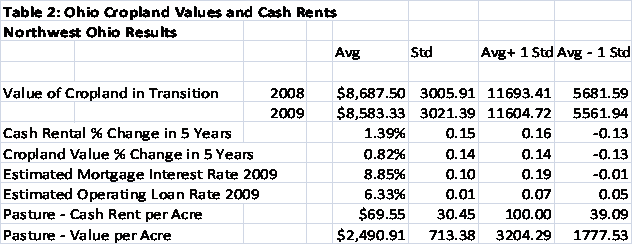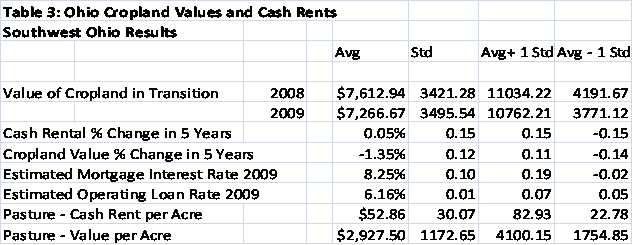Now, more than ever, big swings in crop prices and input costs points toward negotiating some flexibility in cash leases for farmland. “Volatile” and “Uncertain” are two words that might best describe grain prices and input costs for row crop production heading into the 2009 planting season. With this increased volatility and uncertainty, risk increases for producers and more uncertainty arises about the amount of cash rent to pay. On the other side of the negotiating table, landowners, seeing higher profitability in recent years for commodity crops, are possibly seeking higher cash rents. So, just what is that “most equitable” cash rent amount and how can it be maintained from year to year or contract to contract?
One answer is negotiating a flexible cash lease arrangement that varies from year to year based on price, yield and input costs. Price, yield and input cost changes from an agreed upon starting point will trigger changes in the base lease amount. Historically, flexible cash leases have been based on price or yield or a combination of the two. With the extreme volatility in input costs the past 2 years, some producers are only willing to negotiate a flexible cash lease if there is some measure of costs built in to the flex lease.
This Flexible Cash Lease Calculator can assist users in developing a flexible cash rent model. Unlike other flexible cash lease calculators, this tool allows the user to incorporate flexible parameters for input costs as well as for price and yield. The flexible cash rent approach used in this calculator is to multiply the base rent by: 1) the ratio of the Year End Price to Base Price, 2) the ratio of the Year End Yield to Base Yield and, 3) the ratio of the Base Input Costs to Year End Input Costs.
This Flexible Cash Lease Calculator is available at:
http://aede.osu.edu/Programs/FarmManagement/Budgets/download.htm
The Microsoft Excel spreadsheet is designed to enable the user to input base and year end prices, yields and costs to formulate a flex rent at the end of the lease year. There are two tabs for this calculator. Page 1 contains the Flexible Cash Lease Inputs and page 2 contains the Flexible Cash Lease Output.
Flexible Cash Lease Input Page – Page 1
Expected Acres – Expected number of acres to be planted with each crop – corn, soybeans, or wheat.
Base Cash Rent – Rent negotiated between farmer and landowner that will be paid if base prices, yields and input costs remain the same until year end.
Base Yield – Yield negotiated between farmer and landowner corresponding to the base rent. If the Base Yield (or projected yield) ends up being the actual yield, or Year End Yield, yield will not influence the flexible rent calculated.
Year End Yield – The actual yield from the farm or farms. (This could also be a third party end of crop year yield agreed to when the lease is negotiated i.e. county average yield from Ohio Ag Statistics Service.)
Base Price – Price negotiated between farmer and landowner corresponding to the base rent. If the Base Price ends up being the actual price, or Year End price, price will not influence the flexible rent calculated. Base Price may be a 3-5 year average or the best average estimate for the term of the lease.
Year End Price – The actual price crops are sold for or a harvest time price. (This could also be a third party end of crop year price (or an average of a series of prices) agreed to when the lease is negotiated i.e. average price at local elevator on April 1, July 1 and November 1.)
Minimum Rent – Minimum rent agreed to during the lease negotiation. (Optional)
Maximum Rent – Maximum rent agreed to during the lease negotiation. (Optional)
Base N, P2O5, K2O – Input prices negotiated between farmer and landowner at levels corresponding with the Base Rent. These prices could be entered on a per acre basis or a per ton basis. Base Price may be a 3-5 year average or the best average estimate for the term of the lease.
Year End N, P2O5, K2O – The actual cost of these inputs during the production year. (This could also be a third party cost (or an average of a series of costs) agreed to when the lease is negotiated i.e. average cost of inputs at local crop service provider on April 1, July 1 and November 1.)
Base Chemicals – Input prices negotiated between farmer and landowner at levels corresponding with the Base Rent. These prices could be entered on a per acre basis or a per product unit basis. Base Price may be a 3-5 year average or the best average estimate for the term of the lease.
Year End Chemicals – The actual cost of these inputs during the production year. (This could also be a third party cost (or an average of a series of costs) agreed to when the lease is negotiated i.e. average cost of inputs at local crop service provider on April 1, July 1 and November 1.)
Base Diesel – Input price negotiated between farmer and landowner at levels corresponding with the Base Rent. This price could be entered on a per acre basis or a per gallon basis. Base Price may be a 3-5 year average or the best average estimate for the term of the lease.
Year End Diesel – The actual cost of these inputs during the production year. (This could also be a third party cost (or an average of a series of costs) agreed to when the lease is negotiated i.e. average cost of diesel at fuel provider on April 1, July 1 and November 1.)
Base Seed Cost – Input price negotiated between farmer and landowner at levels corresponding with the Base Rent. This price could be entered on a per acre basis, a per bag basis or a per 1000 seed basis. If you choose to use the per acre basis, a per bag basis, enter the figures directly in the Total Base column. If you choose to use the per 100 seed basis enter all information in the section. Base Price may be a 3-5 year average or the best average estimate for the term of the lease.
Year End Seed Cost – The actual cost of these inputs during the production year. (This could also be a third party cost agreed to when the lease is negotiated i.e. average cost of Asgrow seed per unit.)
Flexible Cash Lease Output Page – Page 2
The Calculator allows the user to compare four different methods of calculating a flexible cash lease. The base rent is “flexed” based on factors of “Year End” to “Base” for yield and price and “Base” to “Year End” for inputs. If the “Year End” price or yield is higher than the “Base” price or yield the rent will flex higher. If the “Year End” input costs are higher than the “Base” input costs the rent will flex lower.
These factors are calculated as follows:
Adjusted Price Factor: Year End Price (of crop) divided by Base Price. A “Year End Price” higher than the “Base Price” will yield a factor greater than 1. This Factor multiplied by the “Base Rent” will yield a Flex Rent greater than the Base Rent. A “Year End Price” lower than the “Base Price” will yield a factor less than 1. This Factor multiplied by the “Base Rent” will yield a Flex Rent less than the Base Rent.
Adjusted Yield Factor: Year End Yield (Actual Yield) divided by Base Yield. A “Year End Yield” higher than the “Base Yield” will yield a factor greater than 1. This Factor multiplied by the “Base Rent” will yield a Flex Rent greater than the Base Rent. A “Year End Yield” lower than the “Base Yield” will yield a factor less than 1. This Factor multiplied by the “Base Rent” will yield a Flex Rent less than the Base Rent.
Adjusted Input Factor: Year End Input Costs (Actual Input Costs) divided by Base Input Costs. “Year End Input Costs” higher than the “Base Input Costs” will yield a factor greater than 1. This Factor multiplied by the “Base Rent” will yield a Flex Rent greater than the Base Rent. “Year End Input Costs” lower than the “Base Input Costs” will yield a factor less than 1. This Factor multiplied by the “Base Rent” will yield a Flex Rent less than the Base Rent.
Method I is Flexing for Price Only. This will take your base rent; multiply it by your adjusted price (current price divided by base price). This will equal the rent per acre, which will then be multiplied by acres grown. That will calculate the adjusted rent for the year. The total rent per acre is the sum of the adjusted rent for the year divided by total acres. This is the suggested rental rate for the year.
Method II is Flexing for Price and Yield. This method will use the same methods as above, but include the adjusted yield which is the current yield divided by current price.
Method III is Flexing for Price and Input Costs. This section will combine Method I with the total input costs calculated on the user input page. This will take the adjusted input costs (current input costs divided by base input costs) and multiply it to the adjusted price from Method I.
Method IV incorporates flexing for Price, Yield and Input costs. This will multiply the adjusted price, adjusted yield and adjusted input cost.
In all four methods, the Total Rent per Acre line is the suggested flex rent per acre. Choosing which method to decide rental rates from will come from conversation between land owner and tenant.


